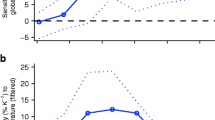Abstract
The effects of environmental vertical wind shear (VWS) on the intensity and rainfall asymmetries in Tropical Storm (TS) Bilis (2006) have been analyzed based on TRMM/TMI-estimated surface rainfall data, QuikSCAT wind fields, 850- and 200-hPa winds of the NCEP-NCAR reanalysis, precipitation data at 5-min intervals from automatic weather stations over mainland China, and the best track data of TS Bilis (2006). The results show that the simultaneous and 6-hour-lagged correlation coefficients between VWS and storm intensity (the minimum central sea level pressure) are 0.59145 and 0.57438 (P < 0.01), respectively. The averaged VWS was found to be about 11 m s−1 and thus suppressed the intensification of Bilis (2006). Distribution of precipitation in Bilis (2006) was highly asymmetric. The azimuthally-averaged rainfall rate in the partial eyewall, however, was smaller than that in a major outer rainband. As the storm intensified, the major rainband showed an unusual outward propagation. The VWS had a great impact on the asymmetric distribution of precipitation. Consistent with previous modeling studies, heavy rainfall generally occurred downshear to downshear-left of the VWS vector both near and outside the eyewall, showing a strong wavenumber-one asymmetry, which was amplified as the VWS increased.
Similar content being viewed by others
References
Bender, M. A., 1997: The effect of relative flow on the asymmetric structure in the interior of hurricanes. J. Atmos. Sci., 54, 703–724.
Black, M. L., J. F. Gamache, F. D. Marks Jr., C. E. Samsury, and H. E. Willoughby, 2002: Eastern Pacific hurricanes Jimena of 1991 and Olivia of 1994: The effect of vertical shear on structure and intensity. Mon. Wea. Rev., 130, 2291–2312.
Blackwell, K. G., 2000: The evolution of hurricane Danny (1997) at landfall: Doppler -observed eyewall replacement, vortex contraction/Intensification, and low-level wind maxima. Mon. Wea. Rev., 128, 4002–4016.
Burpee, R. W., and M. L. Black, 1989: Temporal and spatial variations of rainfall near the centers of two tropical cyclones. Mon. Wea. Rev., 117, 2204–2218.
Cecil, D. J., 2007: Satellite-derived rain rates in vertically sheared tropical cyclones. Geophys. Res. Lett., 34, L02811, doi: 10.1029/2006GL027942.
Chen, S. S., J. A. Knaff, and F. D. Marks Jr., 2006: Effects of vertical wind shear and storm motion on tropical cyclone rainfall asymmetries deduced from TRMM. Mon. Wea. Rev., 134, 3190–3208.
Chen, L.-S., X.-D. Xu, Z.-X. Luo, and L.-Z. Wang, 2002: Introduction to Tropical Cyclone Dynamics. Chinese Meteorological Press, 317pp.
Corbosiero, K. L., and J. Molinari, 2002: The effects of vertical wind shear on the distribution of convection in tropical cyclones. Mon. Wea. Rev., 130, 2110–2123.
Corbosiero, K. L., and J. Molinari, 2003: The relationship between storm motion, vertical wind shear and convective asymmetries in tropical cyclones. J. Atmos. Sci., 60, 366–376.
DeMaria, M., 1996: The effect of vertical shear on tropical cyclone intensity change. J. Atmos. Sci., 53, 2076–2087.
DeMaria, M., and J. Kaplan, 1994: Statistical hurricane intensity prediction scheme (SHIPS) for the Atlantic basin. Wea. Forecasting, 9, 209–220.
DeMaria, M., and J. Kaplan, 1999: An updated statistical hurricane intensity prediction scheme (SHIPS) for the Atlantic and eastern north Pacific basins. Wea. Forecasting, 14, 326–337.
Frank, W. M., 1977: The structure and energetics of the tropical cyclone, Part I: Storm structure. Mon. Wea. Rev., 105, 1119–1125.
Frank, W. M., and E. A. Ritchie, 1999: Effects of environmental flow upon tropical cyclone structure. Mon. Wea. Rev., 127, 2044–2061.
Frank, W. M., and E. A. Ritchie, 2001: Effects of vertical wind shear on hurricane intensity and structure. Mon. Wea. Rev., 129, 2249–2269.
Gallina, G. M., and C. S. Velden, 2002: Environmental vertical wind shear and tropical cyclone intensity change utilizing enhanced satellite derived wind information. Proceedings of the 25 th Conference on Hurricanes and Tropical Meteorology, San Diego, CA. 172–173.
Gray, W. M., 1968: Global view of the origin of tropical disturbances and storms. Mon. Wea. Rev., 96, 669–700.
Hebert, P. J., 1976: Intensification criteria for tropical depressions of the western hurricane-Inez (1966). Mon. Wea. Rev., 104, 418–442.
Jones, S. C., 1995: The evolution of vortices in vertical shear, I: Initially barotropic vortices. Quart. J. Roy. Meteor. Soc., 121, 821–851.
Jones, S. C., 2000: The evolution of vortices in vertical shear, II: initially baroclinic vortices. Quart. J. Roy. Meteor. Soc., 126, 3161–3185.
Jorgensen, D. P., 1984: Mesoscale and convective scale characteristics of mature hurricanes, Part I: General observations by research aircraft. J. Atmos. Sci., 41, 1268–1285.
Knaff, J. A., C. R. Sampson, and M. DeMaria, 2005: An operational statistical typhoon intensity prediction scheme for the Western North Pacific. Wea. Forecasting, 20, 688–699.
Kummerow, C., W. Barnes, T. Kozu, J. Shiue, and J. Simpson, 1996: The tropical rainfall measuring mission (TRMM) sensor package. Journal of Atmospheric and Oceanic Technology, 15, 809–817.
Lonfat, M., F. D. Marks, and S. S. Chen, 2004: Precipitation distribution in tropical cyclones using the tropical rainfall measuring mission (TRMM) microwave imager: A global perspective. Mon. Wea. Rev., 132, 1645–1660.
Marks, F. D., Jr, 1985: Evolution of the structure of precipitation in Hurricane Allen (1980). Mon. Wea. Rev., 113, 909–930.
McAdie, C. J., and M. B. Lawrence, 2000: Improvements in tropical cyclone track forecasting in the Atlantic Basin, 1970–98. Bull. Amer. Meteor. Soc., 81, 989–998.
Merrill, R. T., 1988: Environmental influences on hurricane intensification. J. Atmos. Sci., 45, 1678–1687.
Molinari, J., D. Vollaro, and S. Sbubis, 2000: Origins and mechanism of Eastern Pacific tropical cyclogenesis: A case study. Mon. Wea. Rev., 128, 125–139.
Paterson, L. A., B. N. Hanstrum, and N. E. Davidson, 2005: Influence of environmental vertical wind shear on the intensity of hurricane-strength tropical cyclones in the Australian region. Mon. Wea. Rev., 133, 3644–3660.
Reasor, P. D., M. T. Montgomery, F. D. Marks Jr., and J. F. Gamache, 2000: Low wave structure and evolution of the hurricane inner core observed by airborne and dual-Doppler radar. Mon. Wea. Rev., 128, 1653–1680.
Rodgers, E. B., and E. F. Adler, 1981: Tropical cyclone rainfall characteristics as determined from a satellite passive microwave radiometer. Mon. Wea. Rev., 109, 506–521.
Rogers, R., S. S. Chen, and J. Tenerelli, 2003: A numerical study of the impact of vertical shear on the distribution of rainfall in hurricane Bonnie (1998). Mon. Wea. Rev., 131, 1577–1599.
Wang, Y., and G. J. Holland, 1996: Tropical cyclone motion and evolution in vertical shear. J. Atmos. Sci., 53, 3313–3332.
Wang, Y., and C.-C., Wu, 2004: Current understanding of tropical cyclone structure and intensity changes—A review. Meter. Atmos. Phys., 87, 257–278.
Wang, Y., M. T. Montgomery, and B. Wang, 2004: How much vertical shear can a tropical cyclone resist? Bull. Amer. Meteor. Soc., 85, 661–662.
Wang, Y., 2008: Structure and formation of an annular hurricane simulated in a fully-compressible, nonhydrostatic model —TCM4. J. Atmos. Sci., 65, 1505–1527.
Weber, H. C., and R. K. Smith, 1995: Data sparsity and the tropical-cyclone analysis and prediction problem: Some simulation experiments with a barotropic numerical model. Quart. J. Roy. Meteor. Soc., 121, 631–654.
William, M. F., and A. R., Elizabeth, 2001: Effects of vertical wind shear on the intensity and structure of numerically simulated hurricanes. Mon. Wea. Rev., 129, 2249–2269.
Willoughby, H. E., J. A. Clos, and M. G. Shoreibah, 1982: Concentric eyewalls, secondary wind maxima and the evolution of the hurricane vortex. J. Atmos. Sci., 39, 395–411.
Willoughby, H. E., F. D. Marks Jr., and R. J. Feinberg, 1984: Stationary and moving convective bands in hurricanes. J. Atmos. Sci., 41, 3189–3211.
Wong, M. L. M., and J. C. L. Chan, 2004: Tropical cyclone intensity in vertical wind shear. J. Atmos. Sci., 61, 1859–1876.
Yu, J.-H., X.-D. Xu, L.-S. Chen, and Z.-X. Luo, 2003: A numerical study on vorticity propagation and changes in typhoon intensity. Acta Meteorologica Sinica, 17, 129–145.
Yu, J.-H., and Y. Wang, 2009: Response of tropical cyclone potential intensity over the north Indian Ocean to global warming. Geophys. Res. Lett., 36, L03709, doi: 10.1029/2008GL036742.
Zeng, Z.-H., Y. Wang, and C.-C. Wu, 2007: Environmental dynamical control of tropical cyclone intensity—An observational study. Mon. Wea. Rev., 135, 38–59.
Zeng, Z.-H., L.-S. Chen, and Y. Wang, 2008: An observational study of environmental dynamical control of tropical cyclone intensity in the North Atlantic. Mon. Wea. Rev., 136, 3307–3322.
Zehr, R. M., 2003: Environmental vertical wind shear with Hurricane Bertha (1996). Wea. Forecasting, 18, 345–356.
Author information
Authors and Affiliations
Corresponding author
Rights and permissions
About this article
Cite this article
Yu, J., Tan, Z. & Wang, Y. Effects of vertical wind shear on intensity and rainfall asymmetries of strong Tropical Storm Bilis (2006). Adv. Atmos. Sci. 27, 552–561 (2010). https://doi.org/10.1007/s00376-009-9030-6
Received:
Revised:
Published:
Issue Date:
DOI: https://doi.org/10.1007/s00376-009-9030-6




